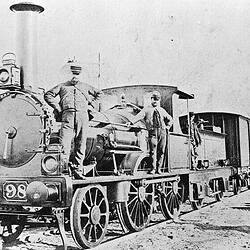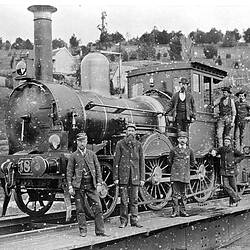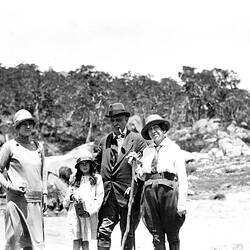Summary
Copy of a black & white photograph depicting one of the 2-4-0 type steam passenger locomotives built by the Phoenix Foundry, of Ballarat, during the late 1870s, for use on the country branch lines or 'light lines' that were built throughout central Victoria between 1873 and 1893. The engines were built in two batches Nos.126-144 (even numbers only), which went into service in 1876-77, and Nos.166-184 (even numbers only), which entered service in 1879-80. All were based on the design of a 'pattern' engine (No.98) built by Beyer Peacock of Manchester and imported in 1874. The engines were originally primarily used for hauling branch line passenger services out of the Ararat, Ballarat, Benalla, Geelong, Princes Bridge, Sale and Seymour locomotive depots. Originally they were equipped with four-wheel tenders but by 1894, most had been given larger six-wheel tenders as shown here.
Although originally unclassed, these engines were later given the F-class designation in alphabetical Victorian Railways locomotive classification scheme introduced from 1886 onwards. In 1910-11, seven of the newest F-class locomotives (Nos.172-184) were converted to 2-4-2 type tank engines, known as the F-motors, for use on outer suburban line passenger services to fill a gap in locomotive capacity left by the delay in electrification of Melbourne's suburban railway network. The remaining unconverted F-class engines were all withdrawn from service and scrapped between 1916 and 1922. The engine was the first of the locally built locomotives and was one of the first to be withdrawn from service in 1916.
Description of Content
Victorian Railways F-class 2-4-0 type steam locomotive No.126 (built by Phoenix Foundry Co., of Ballarat, 1876) hauling a mixed train comprising goods trucks, a passenger carriage, goods van and guards van at the rear. A member of the loco crew leans from the locomotive cabin. Several of the goods trucks are covered with tarpaulins, points and rails of additoinal sidings are visible in the foreground. Behind the train can be seen part of a station platform and Railway Department houses.
More Information
-
Collection Names
-
Collecting Areas
-
Acquisition Information
Copied from Margaret & Noel Dooley, 01 Apr 1985
-
Place & Date Depicted
-
Photographer
-
Manufacturer of Item Depicted
Phoenix Foundry Co Ltd, Armstrong Street, Ballarat, Victoria, Australia, circa 1876
-
Organisation Depicted
-
Individuals Identified
Ferguson, Mr
-
Format
Negative, 35 mm, Black & White
-
Model Name or Number
-
Brand Names
-
Classification
-
Category
-
Discipline
-
Type of item
-
References
[Book] Cave, Norman, et al. 2002. Steam Locomotives of the Victorian Railways, Volume 1: The First Fifty Years. 1., ch.8, pp.60-77 Pages
[Book] VicRail Public Relations Division. 1981. Power Parade.
-
Keywords
![[F-class steam locomotive hauling passenger carriages and goods trucks, Waubra, 1910.]](/content/media/48/154298-small.jpg)



